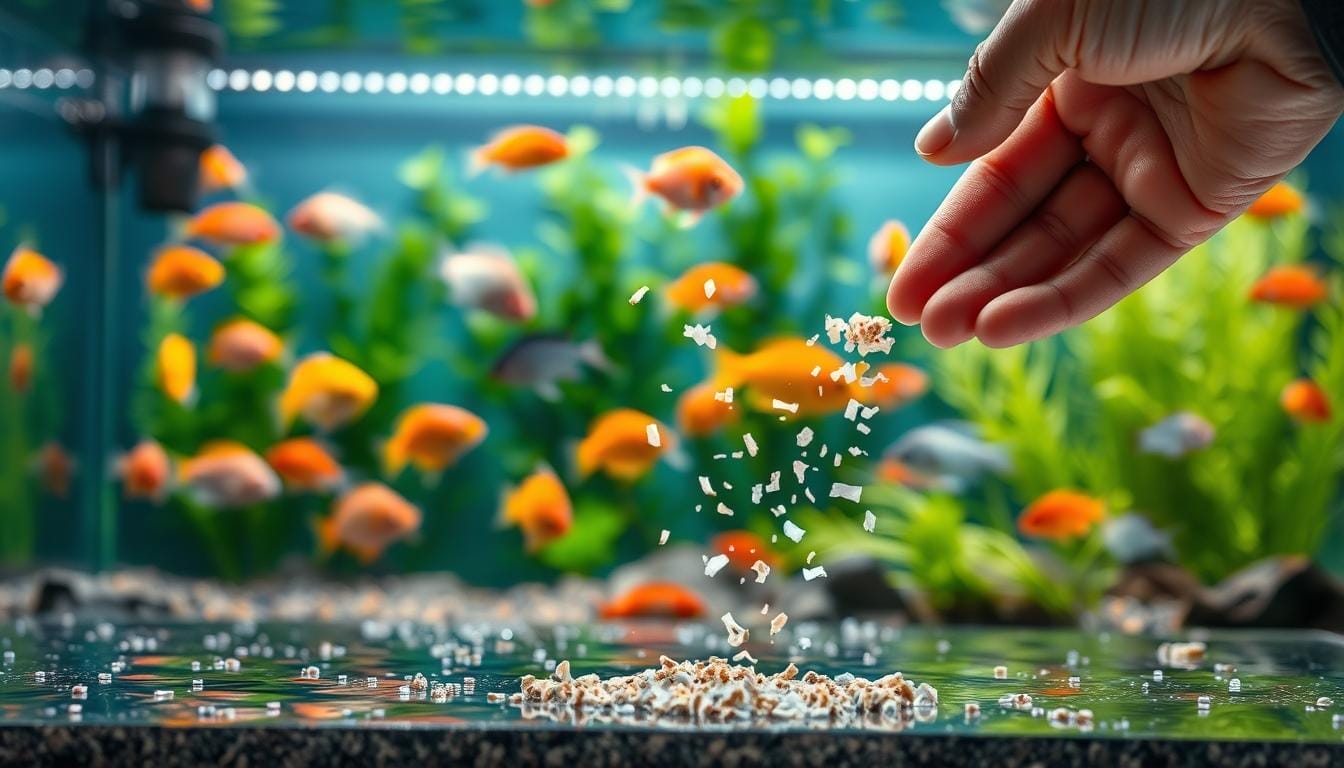
Your Fry Care Guide: Tips for Raising Healthy Fish
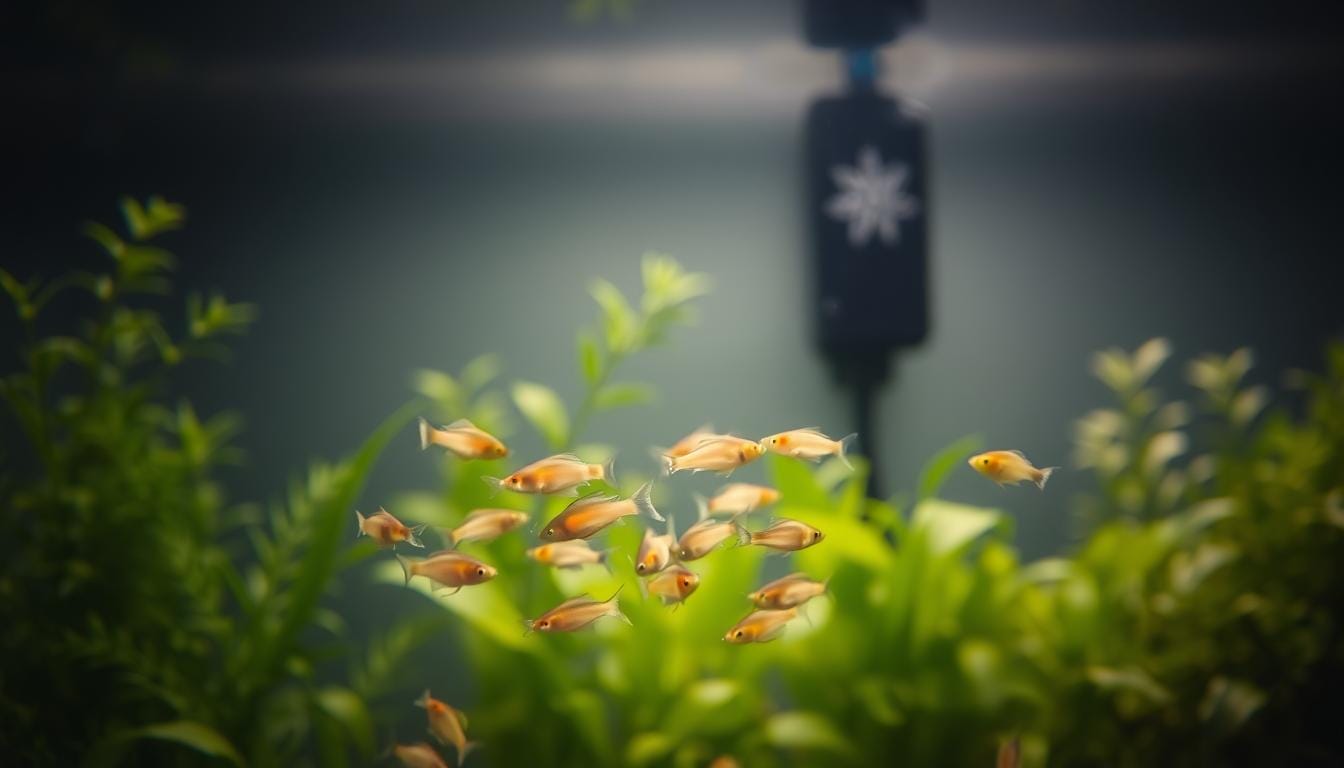
Did you know over 80% of newly hatched fish don’t survive their first week without proper support? That tiny life darting through your tank represents both excitement and responsibility. Whether you’re nurturing accidental fry or intentionally breeding, understanding their needs transforms chance into success.
Raising young fish offers unmatched rewards in the aquarium hobby. Watching them grow from nearly invisible specks to vibrant swimmers creates a connection few experiences match. But these delicate creatures demand specific conditions – get one detail wrong, and entire batches can vanish overnight.
This guide focuses on actionable strategies that boost survival rates. You’ll learn how to maintain ideal water quality, choose the right food for each growth stage, and design a safe tank environment. We’ll break down complex biology into simple steps, like why frequent feedings matter more than you’d guess.
Even beginners can master these techniques with patience. By the end, you’ll know how to spot stress signals early and adjust care routines as your fish develop. Let’s create the perfect foundation for your aquatic babies to thrive!
Understanding the Basics of Fish Fry Care
Those first days of life are crucial for aquatic newborns. Newly hatched fish arrive with a built-in survival kit – their yolk sac. This nutrient-rich bundle fuels them until they develop strength to swim freely. You’ll notice this phase lasts 2-5 days, depending on species.
Water quality becomes non-negotiable during this time. Young fish absorb everything through their skin, making ammonia spikes or pH swings deadly. Test kits become your best friend here. Even slight changes adults tolerate can wipe out an entire brood.
Three key developmental stages demand attention:
- Egg phase: No feeding needed – focus on oxygenation
- Yolk sac stage: Minimal movement, maximum protection
- Free-swimming: Active feeding begins – your cue to start meals
Watch for that magical moment when babies start exploring. Their yolk sacs shrink, and they begin darting purposefully. This signals it’s time for microscopic foods. Handle tank maintenance gently – strong currents or netting can fatally stress delicate swimmers.
Successful rearing means thinking like a nursery, not a community tank. Separate spaces, specialized foods, and daily monitoring make all the difference. Remember: what keeps adults healthy might overwhelm their tiny offspring.
Setting Up a Safe Environment for Fish Eggs and Fry
Aquarium breeding reveals a harsh truth: most adult fish view their offspring as snacks. Creating separation between generations becomes your first priority. The right setup lets eggs develop undisturbed while keeping newborns secure.
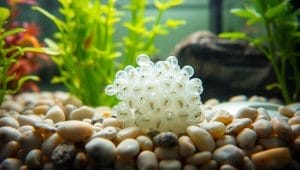
Outsmarting Hungry Parents
Many species instinctively eat freshly laid eggs. For sticky spawners like tetras, try these solutions:
- Yarn spawning mops that catch eggs in tangled fibers
- Dense java moss clusters that act as natural barriers
- Slanted ceramic tiles where eggs roll to safety
Scatter-spawning fish need different tactics. Layer marbles across the tank bottom – eggs fall between them, escaping hungry mouths. Plastic credit cards work wonders for scraping eggs off flat surfaces without damage.
Containment Strategies That Work
Breeder boxes offer dual benefits: they keep fry in familiar water conditions while blocking predators. Choose models with:
• Adjustable flow vents
• Attached moss pads
• Smooth inner surfaces
For species that lay eggs on tank walls, floating mesh dividers create instant protective zones. Always match your approach to the fish’s natural breeding behavior – what works for cichlids might fail with danios.
Fry Care Guide: Handling Hatchlings and Early Fry Stages
The moment your aquatic newborns begin swimming freely marks a critical transition. Immediate separation from adult tanks isn’t just about safety – it turbocharges growth by eliminating food rivalry. Picture this: a pea-sized space where every nutrient goes directly to your babies instead of being snatched by larger fish.
Smaller containers work wonders during this phase. These confined spaces let newborns focus energy on development rather than endless swimming. Here’s why this setup succeeds:
- Reduces travel distance to food sources by 80%
- Prevents exhaustion from strong filtration currents
- Simplifies daily health checks
Transfer timing matters intensely. Move hatchlings within 48 hours of free-swimming behavior using these stress-free methods:
- Siphon water gently into a clean container
- Use airline tubing to control flow speed
- Avoid nets – their delicate fins snag easily
Your first seven days demand eagle-eyed attention. Healthy newborns display steady horizontal swimming patterns, while strugglers may tilt sideways or sink frequently. Daily 25% water changes maintain pristine conditions as their immune systems strengthen.
Watch for these milestones to gauge readiness for larger spaces:
- Consistent appetite for powdered foods
- Visible fin development
- Active exploration beyond hiding spots
Maintaining Excellent Water Quality for Healthy Fry
Clean water isn’t just clear—it’s a lifeline for developing aquatic life. Young fish absorb nutrients and oxygen directly through their skin, making water quality 3x more impactful than for adults. Even trace amounts of ammonia can prove fatal within hours.
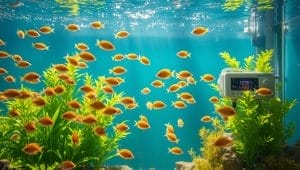
Gentle Filtration Solutions
Sponge filters work best for fragile swimmers. They provide biological cleaning without strong currents. Always add a pre-filter sponge to hang-on-back intakes—this simple step prevents accidental suction of tiny fish.
Three maintenance musts for your setup:
- Rinse sponges in tank water weekly to preserve beneficial bacteria
- Check flow rates daily—babies shouldn’t fight currents to eat
- Position filters near the surface for optimal gas exchange
Mastering Water Changes
Frequent feedings mean more waste. Use airline tubing to siphon debris from the tank bottom—it’s gentler than standard gravel vacuums. White buckets help spot any stray fry during changes.
Follow this routine for stability:
- Replace 20% water daily using temperature-matched liquid
- Treat new water with conditioner before adding
- Test parameters 30 minutes post-change
Remember: sudden shifts in pH or hardness shock delicate systems. Small, consistent adjustments keep your aquatic nursery thriving. With these methods, you’ll create the safe environment young fish need to grow strong.
Effective Feeding Strategies for Growing Fish Fry
Nutrition plays a pivotal role in transforming fragile newborns into robust juveniles. Veteran breeders swear by live baby brine shrimp (BBS) as the ultimate growth booster. These wiggling morsels pack 60% protein and omega-3 fatty acids that fuel rapid development while stimulating natural hunting behaviors.
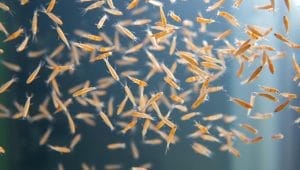
Nutritional Benefits of Live Baby Brine Shrimp
BBS swim actively, triggering your fish’s instinct to chase prey. This movement ensures even shy eaters get nourishment. For best results:
- Offer freshly hatched shrimp within 2 hours of their emergence
- Serve 3-5 small amounts daily to match tiny stomach capacities
- Use a turkey baster for precise portion control
Note: Betta babies need measured portions – overfeeding BBS can cause incurable swim bladder issues. Always remove uneaten food after 20 minutes.
Alternatives: Tiny Worms and Microscopic Foods
Not all newborns can handle BBS initially. For microscopic eaters, try these options:
- Green water: Algae-rich liquid filled with infusoria
- Vinegar eels: Harmless nematodes that wriggle in water columns
- Powdered fry food: Ideal for stationary feeders like angelfish
As your fish grow, introduce crushed flakes or commercial gel foods. Watch for these transition signs:
- Consistent appetite between feedings
- Doubled body size within two weeks
- Active exploration beyond feeding zones
Remember: Frequent, tiny meals beat large portions. Adjust quantities as their bellies round slightly after eating – never let them look bloated.
Monitoring Fry Growth and Proper Separation
Your aquarium’s nursery evolves daily as young fish develop distinct personalities and physical traits. Around 3-4 weeks, you’ll notice some babies outpacing others in size and activity levels. This natural variation demands action to ensure every fish thrives.
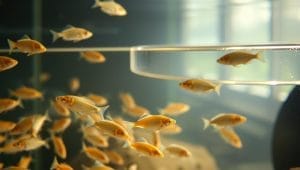
Transferring fish to larger tanks follows a simple rule: when they occupy 70% of their current space during feeding, it’s time to upgrade. A grow-out tank should offer 1 gallon per 10 fish, with gentle filtration and abundant hiding spots.
Why Size Sorting Matters
Dominant fish often hog food, stunting smaller tankmates’ growth. Separating by size creates fair competition and reduces nipped fins. Use transparent containers to observe these differences:
- Fast growers: Round bellies, bold swimming patterns
- Slow developers: Hesitant feeders, pale coloration
Ethical culling requires care. Isolate sickly fish in a quarantine tank first – sometimes they recover with extra attention. For incurable cases, clove oil offers a humane solution.
Move fish during daylight hours using these stress-free methods:
- Dim lights in both tanks
- Match water temperatures exactly
- Use a soft mesh net dipped in tank water
Regular sorting every 10-14 days maintains harmony. You’ll soon spot which babies need more space or specialized food – key skills for raising robust aquatic companions.
Creating Hiding Spots and Natural Cover in Your Aquarium
What if your main tank could double as a nursery? Colony breeding lets you raise fry alongside adults when space is tight. The secret lies in crafting micro-havens where babies vanish from hungry parents but thrive in plain sight.

Smart breeders use floating pond baskets or craft mesh cylinders secured with zip ties. These DIY traps let water flow through while blocking adult access. Position them near feeding areas – fry dart in for meals, then escape to safety.
Live plants become living fortresses for newborns. Try these top performers:
- Java moss: Creates tangled jungles perfect for darting fry
- Water sprite: Feathery leaves filter light and trap food particles
- Dwarf water lettuce: Bushy roots form floating nurseries
Arrange decorations strategically across the tank bottom. Stack smooth stones to create narrow crevices only fry can enter. Artificial caves with multiple exits work wonders for quick escapes. Remember: dense coverage does double duty by improving water quality through natural filtration.
For those exploring community breeding setups, layer plants vertically. Tall stems near the back and midground bushes create depth-based hiding zones. This tiered approach gives fry escape routes at every swim level while keeping your tank visually stunning.
Final Insights for Thriving Fish Fry
Your dedication during these early weeks shapes their future. At 4-5 weeks, begin mixing 0.5mm pellets with freeze-dried arctic copepods. New Life Spectrum’s micro formula becomes their staple food during this transition, packed with nutrients for rapid growth.
Maintain pristine water conditions as their appetites surge. Feed 4-5 tiny portions daily, removing uneaten food within 15 minutes. For those following our detailed four-week protocol, you’ll notice confident swimming and distinct personalities emerging.
Upgrade tank space gradually – sudden moves stress developing systems. By month three, most juveniles handle standard aquarium foods. Watch for these success markers:
• Consistent pellet consumption during feedings
• Vibrant coloration patterns
• Active exploration of all tank levels
Patience rewards you with robust fish ready for their forever homes. Each careful adjustment builds resilience, turning those fragile beginnings into thriving aquatic companions.
FAQ
Why are live baby brine shrimp recommended for feeding newborns?
Newly hatched brine shrimp provide essential nutrients in a size young fish can easily eat. Their movement stimulates natural hunting instincts, encouraging faster growth compared to processed foods.
How do I protect eggs from being eaten by adult fish?
Use a breeder box or mesh divider to separate eggs from adults. Smooth substrates like marbles at the tank bottom also create safe spaces where eggs can develop undisturbed.
How often should I feed tiny fry during their first week?
Offer small amounts of food 4-6 times daily. Their small stomachs require frequent meals, but uneaten food can harm water quality—remove leftovers promptly.
Can I use powdered foods instead of live options?
High-quality powdered or liquid fry foods work if live options aren’t available. However, combine them with microscopic organisms like infusoria for balanced nutrition.
When should I start using a filter in the fry tank?
Add a sponge pre-filter immediately after hatching. It provides gentle flow and prevents babies from being sucked into equipment while maintaining clean water.
How do I know if my water parameters are safe for delicate fry?
Test ammonia, nitrite, and nitrate levels daily. Keep ammonia at 0 ppm, perform 10-15% water changes every other day, and avoid sudden temperature shifts.
At what size can I move fry to a main tank?
Wait until they’re large enough not to fit in adult fish mouths—usually 4-6 weeks. Separate faster-growing individuals earlier to prevent competition.
What plants help create hiding spots for vulnerable fry?
Java moss, guppy grass, or floating plants like duckweed offer cover. These natural barriers reduce stress and improve survival rates in early stages.





